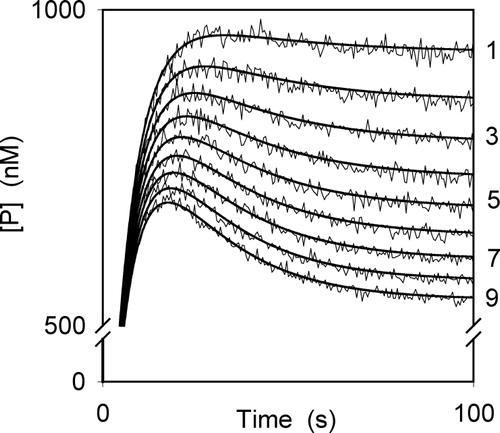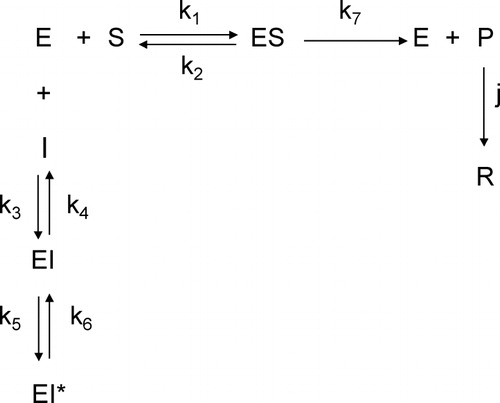Figures & data
Figure 1 Progress curves of the species involved in Scheme obtained by numerical solution of the set of differential equations that describes the kinetics of the enzyme system. The arbitrary values used for the initial concentrations and rate constants are: ,
,

Figure 2 (a) Evaluation of tinflex. A set of points with low values of d[P]/dt are chosen. These points are fitted using a polynomial of degree three. One root of the derivative of this polynomial is tinflex. (b) Evaluation of t∞. Data points at t < tmax, which are located near are chosen. These points are fitted using a polynomial of the degree two. One root of the equation
is t∞. (c) Evaluation of α0. The first data points of d[P]/dt, i.e. data points at low t-values, are fitted using a polynomial of the degree two. The independent term of this polynomial is α0.
![Figure 2 (a) Evaluation of tinflex. A set of points with low values of d[P]/dt are chosen. These points are fitted using a polynomial of degree three. One root of the derivative of this polynomial is tinflex. (b) Evaluation of t∞. Data points at t < tmax, which are located near are chosen. These points are fitted using a polynomial of the degree two. One root of the equation is t∞. (c) Evaluation of α0. The first data points of d[P]/dt, i.e. data points at low t-values, are fitted using a polynomial of the degree two. The independent term of this polynomial is α0.](/cms/asset/e5aa6826-32e5-4d8f-847c-a68aeb223fcc/ienz_a_109648_f0003_b.jpg)
Figure 3 Progress curves simulated with added errors and calculated (continuous lines) using equation (9) corresponding to the proposed example. The values of the rate constants and initial concentrations used are:
for the curves 1–9, respectively.


![Figure 4 (a) Plot of [E]0/(j[P]∞) vs. 1/[S]0 at constant [I]0 according to equation (A29). (b) Plot of [E]0/α0 vs. 1/[S]0 at constant [I]0 according to equation (A31).](/cms/asset/1a7ed6f2-5068-4ec8-b157-b2cdfb3ad67f/ienz_a_109648_f0005_b.jpg)
![Figure 5 (a) Plot of ([S]0[E]0)/(j[P]∞) vs. [I]0 at constant [S]0 according to equation (A29). (b) Plot of ([S]0[E]0)/α0 vs. [I]0 at constant [S]0 according to equation (A31).](/cms/asset/3688930d-0333-4ec4-bab4-bd841a6c14f1/ienz_a_109648_f0006_b.jpg)